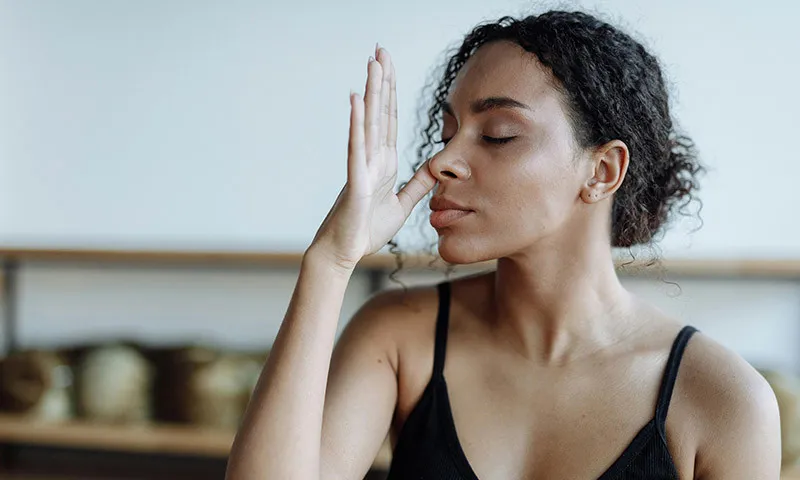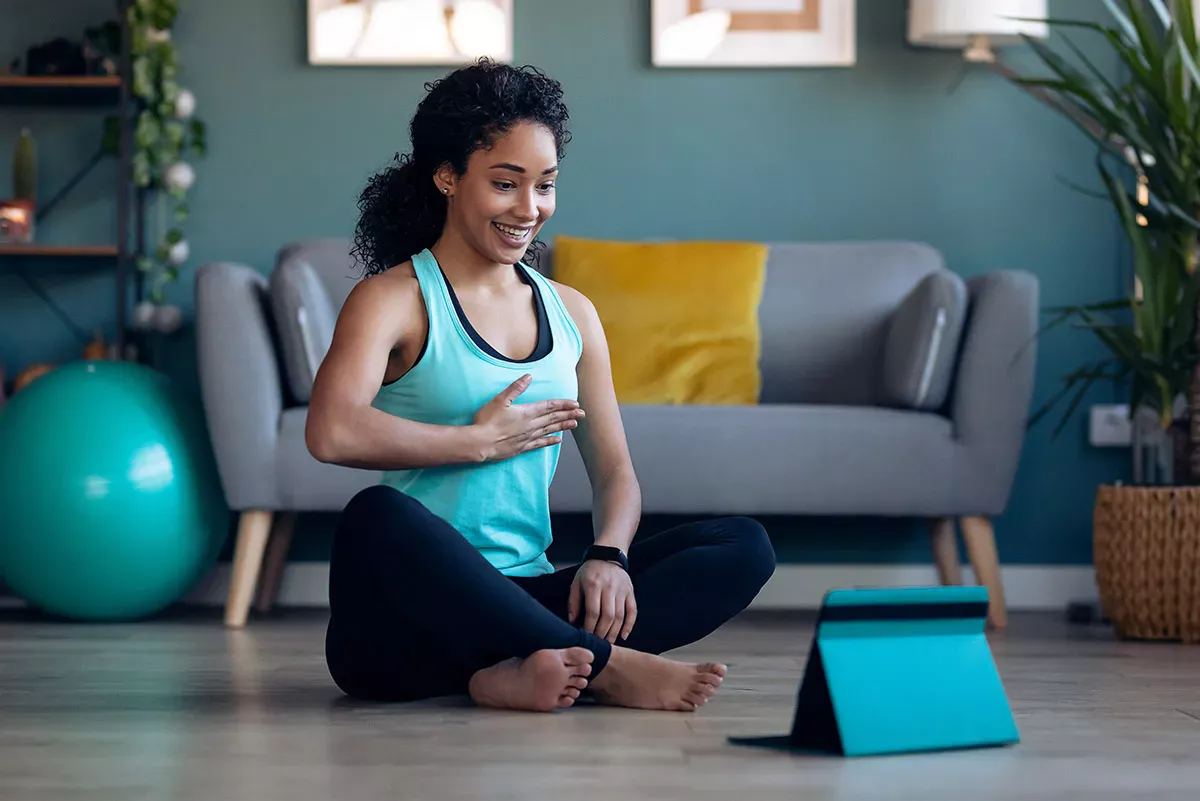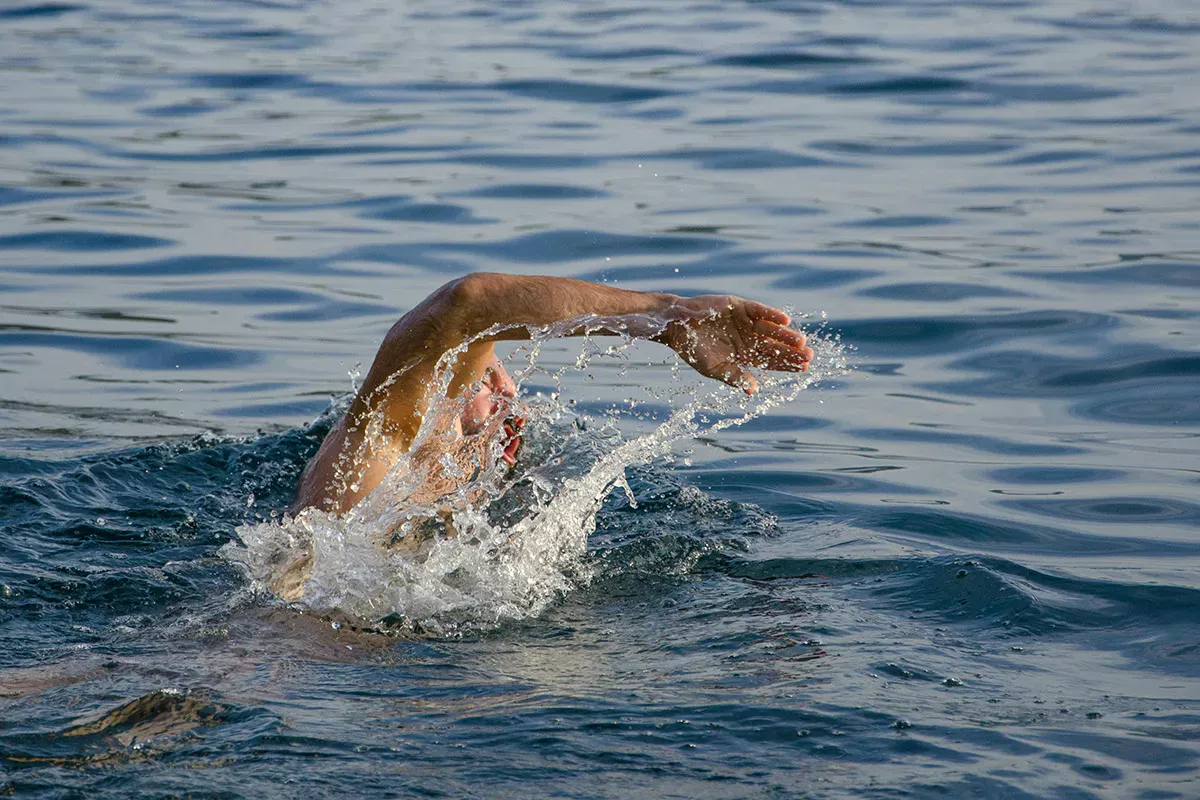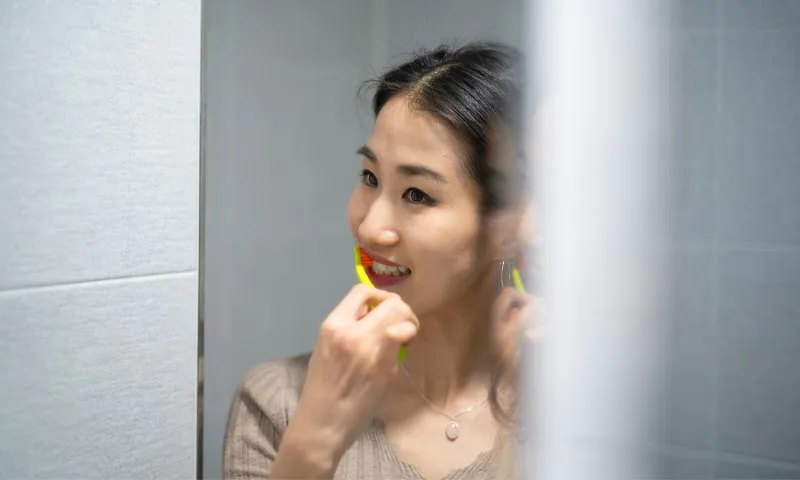What happens when you breathe?
With every breath we take, we inhale billions of microscopic oxygen molecules to supply our brain, organs, bones and muscles with oxygen. Our upper body muscles contract, the chest opens and the air can flow in. The oxygen molecules are inhaled through the mouth or nose and enter the bloodstream via the lungs. When we breathe out, we release carbon dioxide.
Why is it important to breathe properly?
The topic of "breathing properly" is all the rage: there are numerous books, YouTube videos and even apps that want to teach you the right technique. But why the sudden hype? People have been breathing for thousands of years and it is generally known that breathing is vital - after all, the human body can go for weeks without food, days without water, but only minutes without air.
There is a reason for this sudden interest: science has only recently discovered that the way we breathe is crucial for many areas of health.
Correct breathing can achieve the following results:
- Increase concentration and attention
- Lower blood pressure
- Regulate the nervous system
- Increase performance in sport
- Stop panic attacks
Breathing correctly can therefore increase your well-being enormously. This is why breathing techniques can also be used as a therapeutic measure - for example for COPD, migraines and asthma. For patients with high blood pressure and anxiety disorders, it has already been scientifically proven that correct breathing helps. For many other complaints, there is already evidence that still needs to be scientifically investigated - for example, menopausal symptoms. But one thing is certain: correct breathing will become increasingly important in medicine in the future.
One of the reasons for this is the special position that our breathing has as a bodily function: If we don't think about it, our body simply breathes on its own - in autopilot mode, so to speak. Other vital processes also run completely automatically, such as heartbeat and digestion. This is also referred to as the "autonomic nervous system", which controls these automatic processes. For example, we automatically breathe faster when we are nervous and slower when we are relaxed.
However, breathing plays a special role: In contrast to digestion and heartbeat, we can consciously control our breathing and thus directly influence other vegetative body processes. If we consciously breathe slowly and calmly in a stressful situation, we are signalling to the body that there is no danger. The heartbeat automatically slows down and we relax. Breathing therefore plays an exciting dual role between the conscious and subconscious bodily functions.
How do you breathe properly? Through the nose!
The good news is: you can learn to breathe properly! If you want to breathe properly, you should definitely get into the habit of always breathing through your nose. This has numerous advantages: On the one hand, the lungs can absorb up to 20 per cent more oxygen than when breathing through the mouth. On the other hand, nasal breathing protects the airways because the air arrives warm, moisturised and purified. This means that bacteria and viruses have less chance of settling and spreading. When we breathe through our nose, we can also concentrate better, have more energy and sleep better than when we breathe through our mouth. Particularly exciting: a US study found that the different areas of the brain communicate better with each other when breathing through the nose. For example, people who breathe through their nose are better at recognising other people's emotions and have a better memory.
Conversely, breathing through the mouth can have negative consequences: in addition to a poorer oxygen supply, mouth breathing can trigger asthma, sleep apnoea, snoring and tension in the jaw and neck. The teeth also suffer: As the mouth is constantly open, more bacteria can enter the oral cavity and attack the teeth. The risk of tooth decay, gum inflammation and periodontitis increases. If air is constantly passing through the mouth, it dries out the oral cavity, which impairs the protective effect of saliva.
If you want to make sure that you breathe through your nose at night and not through your mouth, you can use mouth plasters. These are special plasters that you stick over your mouth and ensure that you cannot open your mouth at night. This forces you to breathe through your nose. Another aid in the fight against mouth breathing, snoring and blocked noses are so-called nasal spreaders, which allow more air to flow through the nose.
Nasal breathing in children
Nasal breathing is particularly important in babies and children: whether a child breathes through the nose or through the mouth can determine how the head shape and jaw develop. Children who breathe through their nose develop a face with defined cheekbones, straight teeth, a straight nose and an overall wider facial shape. In contrast, children who breathe mainly through the mouth often develop a rather narrow face with less defined cheekbones, a crooked nose and misaligned jaws - and crooked teeth as a result.
Scientific studies have shown that around 50 per cent of children breathe through their mouths - and the same applies to adults. There are a number of reasons for this: Crooked nasal septums, muscle dysfunction in the mouth and face area ( Myofunctional disorder), allergies and even incorrect posture can lead to a child preferring to breathe through their mouth - but it can also simply be a bad habit that they have picked up from somewhere.
Children with a shortened tongue tie also often prefer mouth breathing. It is interesting to note that mothers of children with a shortened tongue tie almost always have difficulties breastfeeding. However, this has not yet been widely recognised by experts. Midwives often try to treat the mother in the event of breastfeeding difficulties, while the actual problem lies with the baby. A shortened tongue tie can be treated with a short surgical procedure that is hardly painful for the child but prevents serious long-term consequences: An untreated shortened tongue tie can lead to mouth breathing, speech disorders, misaligned teeth and an increased risk of tooth decay.
When you consider the far-reaching consequences of the right or wrong breathing technique for children's development, one thing is clear: parents should pay attention to whether their child is breathing through their nose from birth.
Good to know:
Parents should not take the choice of dummy lightly. The right pacifier can promote mouth breathing, while the wrong model can lead to misaligned teeth. Find out what to look out for in our article:
Belly breathing or chest breathing?
Chest breathing is superficial and shallow, while abdominal or diaphragmatic breathing is deep and utilises the entire lung volume. In chest breathing, only a tenth of the diaphragm's room for manoeuvre is used, while abdominal breathing involves the entire upper body including the chest and flanks. You can probably already guess that abdominal breathing is the right breathing technique - and you're absolutely right. When we breathe in deeply - all the way to our stomach - our entire body can be supplied with oxygen. We feel calm and relaxed. When we breathe properly into our belly, we even generate positive feelings such as joy and happiness. Conversely, if we breathe too shallowly and superficially, our body becomes tense and produces negative feelings such as anger, fear and inner restlessness because the body is in a state of alarm.
If we only breathe in shallowly and superficially instead of utilising the entire volume of our lungs, our body cannot be supplied with sufficient oxygen. The result: tiredness, difficulty concentrating and headaches. It is particularly unfavourable that we breathe quickly and superficially, especially in tense situations - for example during an important exam. This can exacerbate negative feelings such as anxiety and panic, which in turn can lead to us feeling like we can't breathe and breathing even faster. This starts a vicious circle that we can only break by consciously breathing deeply into our stomach.
Nowadays, superficial chest breathing is standard for many people: we spend most of the day sitting at our desks or looking at our mobile phones. If we don't pay particular attention to maintaining an upright posture, our upper body is usually bent over. In these situations, the lungs are automatically constricted and cannot develop properly. The body adapts and only breathes superficially into the chest. The result: we are constantly under stress and constantly feel a subliminal anxiety because our body is constantly on alert.
Learning to breathe correctly: 3 breathing exercises
Want to practise breathing properly? Then these four exercises are just right for you. If you consciously pay attention to your breathing in everyday life and practise it, you will soon notice improvements. You will have more energy, be able to concentrate better and even be in a better mood. Alternatively, you can also integrate yoga or meditation into your everyday life - these also focus on correct breathing.
Breathing exercise 1: Measure relative breathing volume
Is there a test we can use to determine how well we breathe? Yes, there is!
- Sit up straight and breathe in and out calmly through your nose.
- Prepare a stopwatch - for example on your smartphone.
- After exhaling, hold your nose and start the stopwatch.
- Hold your breath.
- Stop the time as soon as you have a clear need to breathe in again.
- Continue to breathe normally through your nose.
If the stopped time is less than 25 seconds, it is very likely that your breathing is not ideal at the moment and that you are suffering from symptoms such as nasal congestion, asthma, fatigue, lack of concentration or even anxiety and panic attacks. With an optimal breathing technique, you should be able to hold your breath for 40 seconds. This test was developed by the Russian doctor Konstantin Pavlovich Buteyko, who drew attention to the importance of nasal breathing back in the 1990s and developed a series of breathing exercises.
Breathing exercise 2: Develop awareness of correct breathing
If you haven't paid attention to your breathing before, you first need to discover what it feels like to breathe into your belly. You can easily use this exercise in everyday life to check whether you are breathing correctly.
- Sit up straight and breathe in and out calmly through your nose.
- Place one hand on your chest and feel how your chest rises when you inhale and falls when you exhale.
- Continue to breathe in and out in a relaxed manner. Now place one hand on your stomach and feel how your stomach bulges outwards when you inhale and collapses again when you exhale. If you don't feel any movement in your stomach when you breathe in, you need to breathe in more deeply. Important: You don't have to suck in huge amounts of air. Abdominal breathing already works during normal, relaxed breathing.
- Continue to breathe in and out in a relaxed manner. Now place one hand on either side of you so that you can feel your lower ribs. As you inhale, you will feel the ribs move outwards. If you don't feel this, you need to breathe in more deeply.
Breathing exercise 3: 4-7-11 breathing technique for relaxation
If you are tense and stressed, this exercise works wonders to put you in a state of relaxation. You can use it before an exam, for example, or in an emotionally tense situation to calm yourself down. It can also help with stress, difficulty falling asleep and even panic attacks. By breathing deeply and slowly, the body senses that there is no danger and that it can relax.
- Breathe in through your nose and count to four internally.
- Breathe out slowly and count to seven. If you find this difficult at the beginning, you can start by counting to five and then slowly increase your count. It is important that the exhalation takes longer than the inhalation.
- Continue to breathe in and out evenly in this pattern for eleven minutes.
Breathing exercise 4: 4-7-8 breathing technique for concentration
To be fully present in the here and now and increase your concentration, you can use a technique in which you hold your breath between inhaling and exhaling. This breathing exercise increases our attention and can easily be integrated into everyday school or work life.
- Sit up straight and relax. You are also welcome to close your eyes.
- Breathe deeply into your stomach through your nose and count to four internally.
- Hold your breath and count to seven internally.
- Breathe out slowly through your mouth and count to eight internally.
- Breathe in and out at least four more times in this pattern.
If you find it difficult to hold your breath for this long at the beginning, you can start by counting to five and slowly work your way up to seven. The same applies to exhaling. The important thing with this exercise is that holding your breath is longer than inhaling and exhaling is longer than holding your breath.
Breathe correctly in different situations
So far, we have described how to breathe correctly in everyday life - in other words, when your body is not actually under any great strain. But what is the correct breathing technique in exceptional physical situations?
Breathe correctly during sport
When we exert ourselves while cycling, doing gymnastics at or jogging, we can get out of breath. Here you can find out how to breathe properly during sport:
Breathe correctly when jogging
In principle, you should also breathe through your nose when jogging if possible. However, it depends on the intensity of the training: During easy training, you should breathe in and out through your nose because the air arrives in your lungs pre-filtered and warmed up and you can absorb 20 per cent more oxygen. For medium to intensive training, you should breathe in through your nose and out through your mouth. During very strenuous exercise, you can also breathe in through your mouth. The more you practise nasal breathing while jogging, the longer you will be able to maintain it, even with increasing exertion. Nasal breathing during sport can be trained! Many athletes also swear by synchronising their breathing with their running rhythm. For example, you can breathe in for two steps and breathe out for three steps.
Breathe correctly when swimming
Swimming poses an additional challenge: we cannot breathe underwater. It therefore goes without saying that we inhale when our head is above the water and exhale when it is in the water. Many amateur swimmers run out of breath because they do not exhale sufficiently underwater. The body reacts just as sensitively to an excessively high concentration of carbon dioxide as it does to a lack of oxygen. When swimming, breathing out correctly is therefore at least as important as breathing in correctly.
Breathing correctly when crawling looks like this: Keep your head half in the water as you inhale so that only one glass of the swimming goggles is above the water and inhale evenly with your mouth until the thumb of your pulling arm touches your thigh. Breathe out evenly under water through your nose and mouth. When crawling, swimmers often inhale on every third or fourth breath.
In breaststroke, you breathe in while your head is completely above the water. While you are underwater, breathe out and pull your arms backwards from the front - as if you want to push the water away. When you stretch your arms forwards again, resurface and breathe in again. At the same time, bring your legs together.
Breathe properly when hiking
Breathing properly also plays an important role when hiking and mountaineering. According to experts, when hiking at altitudes below 5,000 metres, you should breathe through your nose if possible in order to better supply your body with oxygen. Above 5000 metres or on difficult passages that require physical exertion, you can switch to breathing through your mouth. You can also practise breathing through your nose in everyday life - for example when walking or climbing stairs. Just like when jogging, you can also let your breathing dictate your pace when hiking or walking - for example, breathe in for one step and out for the next two steps.
Breathe correctly during strength training
When we lift something heavy, many people automatically hold their breath - this is also known as pressurised breathing. You can see this in the bright red faces of amateur bodybuilders in the gym. However, this is not healthy: pressurised breathing increases blood pressure. It's better if you consciously exhale during the weight lifting phase and inhale during the release phase. If you are doing push-ups, for example, this means that you inhale when going down and exhale when pushing up.
Breathe correctly when speaking
During presentations or when reading aloud, our voice reveals a lot about our state of mind. If we have stage fright, our voice can sound shaky or higher than usual, and it can start to crack. The reason for this is that we breathe too quickly and too shallowly under tension and don't take time to breathe out.
Voice coaches therefore recommend leaving your mouth open when speaking so that the air can flow out. Breathing in deeply not only provides us with sufficient oxygen, but also ensures that the unpleasant side effects of nervousness, such as a racing heart and shaky hands, also improve. It's best to practise breathing correctly when speaking at home before your presentation. You can also place a hand on your stomach to check whether you are breathing in deeply enough.
Breathe correctly during labour
You are probably familiar with film scenes in which pregnant women do breathing exercises in a birth preparation course or in which a woman in labour is breathing particularly intensively. There is a good reason for this: breathing correctly is extremely important during labour. If women breathe too shallowly and quickly during labour, the body tenses up. This can delay labour and increase pain - especially if this is accompanied by fear of the birth. Ideally, women should breathe deeply into their abdomen to loosen and relax the body so that the baby can find its way into the world via the birth canal.
Experts recommend that women should adhere to three main principles when giving birth:
- Do not hold your breath, but keep breathing continuously so that your body does not tense up.
- Breathe in through your nose deep into your stomach.
- Breathe out slowly through your mouth.
The exhalation should take about three times as long as the inhalation. During labour in particular, it helps women if they make sounds - such as a long "Ahhh" or "Ohhh" - when they exhale. This should also loosen the cervix and pelvic floor.
Breathe properly under respiratory protection
The right breathing technique is not only important in everyday life, but also in extreme situations: If firefighters breathe consciously while wearing breathing protection, they can not only reduce the air consumption of the breathing air cylinder by up to 30 per cent, but also prevent a life-threatening breathing crisis. Conscious breathing also lowers the heart rate and means that rescue workers are less exhausted after physically strenuous activities.
Breathe correctly in everyday life: 5 tips
You now know that breathing correctly is essential for your health and can be learnt. But how do you put this into practice in everyday life? We've put together five simple tips for you:
1. Check-ins in between
Check several times a day whether you are breathing through your nose or your mouth. Also consciously pay attention to whether your stomach bulges outwards when you breathe in. If you find yourself breathing in through your mouth when you are not exerting yourself physically, you should consciously switch to breathing through your nose. Get into the habit of consciously paying attention to your breathing when you don't need to concentrate - for example when doing the washing up, on the way to work or in the shower.
2. Upright posture
A bent posture constricts the lungs and ensures that we automatically breathe too shallowly. If we sit upright at a desk and look at a screen at eye level, we can breathe in deeply much more easily. Also be careful not to wear clothes that are too tight and don't allow you to breathe properly.
3. Breathing exercises in between
To integrate breathing exercises into your everyday life, you don't have to carve out hours of time when you're busy anyway. You can simply squeeze them in between. For example, simply use the 4-7-8 breathing technique at your desk when you realise that your concentration is waning and you need to refocus. You can also make the 4-7-11 technique a wonderful bedtime ritual when you are already in bed.
4. Fresh air
It is not only important how we breathe, but also what we breathe in. Exercise regularly outdoors and let fresh air into your home or office. When walking or running, you can also consciously adjust your steps to your breathing rhythm.
5. Conscious stress management
Is the deadline approaching and your project is anything but finished? Are you annoyed with someone in your private life? Or you have the feeling that everything is just getting too much for you? When you are emotionally stressed, your body is under tension. Breathing properly in this situation will help you to calm down and relax. Make sure that you exhale for longer than you inhale. Ideally, you should use the 4-7-11 technique.
Good to know:
You probably brush your teeth twice a day, but do you even know what the - scientifically proven - most efficient tooth brushing technique is? We'll tell you here
Sources
Bayerischer Rundfunk: The 4-7-11 breathing technique helps against stress and sleep problems | Good to know, on: youtube.com.
Böhl, Lukas: Breathing properly with a face mask, on: stuttgarter-nachrichten.de.
Birkholz, Nathalie: The right breathing technique for the birth, on: eltern.de
Buteyko Clinic International: The Buteyko Method.
DAK Gesundheit: The right breathing technique for sport.
Decathlon: Breathing while swimming.
Focus online: How to breathe properly at every opportunity and Psychology professor: Simply switch off stress with the 4-7-11 method.
Geo: Nose instead of mouth: The right breathing technique for hiking.
Hamasaki, Hidetaka: Effects of Diaphragmatic Breathing on Health: A Narrative Review, in: Medicines. 2020.
Hartmann, Josephin: Focus sharpening: 7 effective concentration exercises for pupils, on: familienservice..de.
Kiesel, Kyle et al: Exercise intervention for individuals with dysfunctional breathing: a matched controlled trial, in: International Journal of SPorts Physical Therapy. 2020.
Children's language: Myofunctional disorders.
Laarz, Diana: Correct breathing - myofunctional disorders: Controlling the breath - and healing with it, on: geo.de.
Logicana: Why does my child breathe through its mouth?
McKeown, Patrick: How to Breathe While Running, on: oxygenadvantage.com and Shut your Mouth and Change your life, on: youtube.com.
Nürnberger Versicherung: The right way to breathe when swimming: Training tips for the triathlon.
Nestor, James: Breath. Breath. New knowledge about the forgotten art of breathing. 2020.
Philippot, Pierre et al: Respiratory feedback in the generation of emotion, in: Cognition and Emotion. 2010.
LTG 8 practice clinic: How unhealthy mouth breathing can also cause misaligned jaws.
Quarks: Breathe properly, on: ardmediathek.de.
Saur, Regina: That's what breathing is all about, on: swrfernsehen.de.
Strobl, Ingrid: Richtig atmen - Verbindung von Körper und Seele, on: swr.de.
Swimrun Germany: Breathing while swimming - why exhaling is so important.
Voslamber, Christine: What are the consequences of constant breathing through the mouth, on: kieferorthopädie-in-berlin.de.
Williams, Caroline: How to breathe your way to better memory and sleep, on: newscientist.com.
Wolf, Michael: Simple breathing training for extreme situations, on: feuerwehr-ub.de
Zelano, Christina et al: Nasal Respiration Entrains Human Limbic Oscillations and Modulates Cognitive Function, in: Journal of Neuroscience. 2016.
Zidaric, Daniel-Juraj: Breathe properly when running, on: bergezit.de.
Future tooth: Shortened frenulum of tongue - symptoms, consequences and treatment.
All websites last accessed on 18/01/2024.
 Swiss premium oral care
Swiss premium oral care









